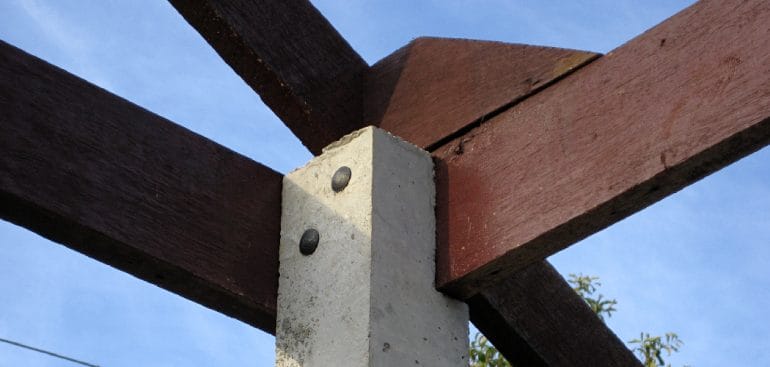Yes, cement can adhere to wood surfaces when used correctly. Proper surface preparation and the use of a bonding agent can help ensure a strong bond between cement and wood. Whether it’s for construction or DIY projects, using cement on wood can provide added durability and strength. However, it’s important to follow specific instructions and consider the type of wood and cement being used to achieve the best results. With the right technique and materials, cement can effectively stick to wood surfaces, enhancing their structural integrity.

Exploring the Bond Between Cement and Wood
When it comes to construction materials, cement and wood are often seen as two distinct options with different uses. However, there are situations where these two materials can be combined to create a unique and durable bond. In this section, we will explore the bond between cement and wood, discussing its benefits, applications, and techniques.

Benefits of the Cement-Wood Bond
The bond between cement and wood offers several advantages that make it a viable option in certain construction projects. Here are some benefits of using cement to bond wood:
- Strength and Durability: The combination of cement and wood creates a bond that is strong and long-lasting. This makes it suitable for applications that require high structural integrity.
- Water Resistance: The use of cement can enhance the water resistance of wood, protecting it from rot, decay, and moisture damage.
- Fire Resistance: Cement is inherently fire-resistant, making the cement-wood bond suitable for applications where fire safety is a concern.
- Design Flexibility: The use of cement allows for unique and creative designs that combine the natural beauty of wood with the versatility of cement.
Applications of the Cement-Wood Bond
The cement-wood bond finds applications in various construction projects. Some common uses include:
- Structural Support: Cement can be used to reinforce wooden beams and columns, providing additional strength and stability.
- Exterior Cladding: Cement can be applied as a protective layer over wooden facades, enhancing their durability and weather resistance.
- Outdoor Furniture: Cement can be used to create sturdy and weather-resistant outdoor furniture pieces that incorporate wooden elements.
- Artistic Installations: The unique combination of cement and wood allows for the creation of visually striking art installations and sculptures.
Techniques for Bonding Cement and Wood
There are various techniques available for bonding cement and wood together. Here are a few commonly used methods:
- Adhesive Bonding: Specialized adhesives designed for bonding wood and cement can be used to create a strong and durable bond between the two materials.
- Mechanical Fasteners: Screws, nails, or bolts can be used in conjunction with cement to create a secure connection between wood and cement surfaces.
- Overlaying: In this technique, a layer of cement is applied over the wood surface, creating a protective and decorative coating.
- Embedding: Wood can also be embedded within wet cement, creating a seamless integration between the two materials as the cement cures.
In summary, the bond between cement and wood offers unique benefits and applications in the field of construction. By combining the strength and durability of cement with the natural beauty of wood, designers and builders can create structures and installations that are both visually appealing and structurally sound.

Factors influencing the bonding of cement on wood
When it comes to bonding cement onto wood, there are several factors that can affect the quality and durability of the bond. It’s important to understand these factors in order to achieve a strong and long-lasting bond between cement and wood surfaces. Let’s explore the key factors that influence this bonding process:
1. Surface Preparation
The surface preparation of both the cement and wood surfaces plays a crucial role in achieving a strong bond. It is essential to ensure that both surfaces are clean, dry, and free from any contaminants such as dust, dirt, grease, or oil. Any impurities on the surfaces may prevent proper adhesion and compromise the bond strength.
It is recommended to sand the wood surface before applying cement to create a rough texture, which enhances the mechanical interlocking between the cement and the wood. Additionally, the wood surface should be free from any loose or damaged fibers that can weaken the bond.
2. Cement Composition
The composition of the cement also affects its bonding capability with wood. Portland cement, which is commonly used for bonding purposes, contains various additives that can enhance adhesion. These additives, such as latex or acrylic-based polymers, improve the flexibility and bonding strength of the cement.
It’s important to choose a cement product that is specifically designed for bonding to wood surfaces. These specialized cement products have properties that promote adhesion to wood and provide long-term durability.
3. Moisture Content
The moisture content of both the cement and wood surfaces is a critical factor in achieving a strong bond. It is essential to ensure that the wood surface has an appropriate moisture level, as excessively dry or wet wood can hinder the bonding process.
If the wood is too dry, it may absorb moisture from the cement too quickly, leading to shrinkage and weakened bond strength. On the other hand, if the wood is too wet, it can prevent proper adhesion and cure of the cement.
4. Application Technique
The application technique used to apply the cement onto the wood surface also influences the bonding process. It is important to follow the manufacturer’s instructions regarding the mixing ratio, application method, and curing time.
Applying the cement evenly and with adequate coverage ensures proper contact and adhesion between the cement and wood surfaces. It is also crucial to pay attention to the curing time and conditions specified by the manufacturer to allow the cement to fully bond with the wood.
5. Environmental Conditions
The environmental conditions during and after the bonding process can impact the quality of the cement-wood bond. Temperature and humidity levels can affect the curing time and overall bond strength.
It is recommended to perform the bonding process in a controlled environment with moderate temperature and humidity levels. Extreme temperatures or high humidity can interfere with the curing process and compromise the bond quality.
In summary, achieving a strong bond between cement and wood requires proper surface preparation, choosing the right cement composition, considering moisture content, applying the cement correctly, and ensuring suitable environmental conditions. By paying attention to these factors, you can enhance the bonding capability and achieve a durable bond between cement and wood surfaces.

Tips for Successfully Using Cement on Wood Projects
Using cement on wood projects can offer a range of benefits, from added strength and durability to a unique aesthetic appeal. However, it is important to follow certain tips and guidelines to ensure successful results. Whether you are working on a DIY project or a professional construction job, here are some valuable tips to help you use cement effectively on wood:
1. Prepare the Surface
Before applying cement to wood, it is crucial to prepare the surface properly. Start by cleaning the wood thoroughly to remove any dirt, debris, or loose particles. Sand the surface to create a rough texture, which helps the cement adhere better. Additionally, make sure the wood is free from any oils, waxes, or finishes that may interfere with the bonding process.
2. Use the Right Type of Cement
Choosing the correct type of cement is essential for a successful outcome. There are various types of cement available, such as Portland cement, epoxy cement, or polymer-based cement. Consider the specific requirements of your wood project and select a cement that is suitable for both wood and the intended purpose.
3. Apply a Bonding Agent
To enhance the bond between the cement and wood, it is advisable to apply a bonding agent or primer. This helps create a strong adhesion and prevents the cement from cracking or separating from the wood. Follow the instructions provided by the manufacturer to apply the bonding agent properly.
4. Mix the Cement Correctly
When working with cement, it is crucial to mix it correctly to achieve the desired consistency. Follow the instructions on the cement packaging and use the appropriate amount of water. Avoid adding too much water, as it can weaken the mixture and compromise its strength. Use a mixing container and a mixing tool to ensure a thorough and uniform blend.
5. Apply Cement in Thin Layers
When applying cement to wood, it is best to do so in thin layers. Thick layers may result in uneven drying, increased shrinkage, and potential cracking. Apply a thin and even layer of cement, and allow each layer to dry completely before adding another. This approach ensures a strong bond and minimizes the risk of structural issues.
6. Consider Reinforcement
Depending on the specific wood project, you may want to consider reinforcing the cement with additional materials. For example, using wire mesh or metal bars can provide added strength and stability. This is especially important for load-bearing structures or projects subject to significant stress or weight.
7. Protect and Seal the Cement
To prolong the lifespan of the cement and protect it from external elements, apply a sealer or protective coating. This can help prevent moisture penetration, mold growth, and deterioration. Choose a sealer specifically designed for cement surfaces and follow the manufacturer’s instructions for application.
8. Maintain Proper Ventilation
When working with cement, it is essential to ensure proper ventilation. Cement releases fumes and dust particles that can be harmful if inhaled. Open windows, wear a mask, and use exhaust fans to maintain adequate airflow and minimize exposure to these substances.
9. Follow Safety Precautions
Lastly, always prioritize safety when working with cement. Wear appropriate personal protective equipment, such as gloves, safety glasses, and a dust mask. Follow the manufacturer’s instructions for handling, storing, and disposing of cement and related products.
By following these tips, you can successfully use cement on wood projects, achieving durable, long-lasting results. Remember to prioritize proper preparation, selection of the right cement, and adherence to safety precautions for a successful outcome.
Alternatives to Cement for Attaching Wood Materials
When it comes to attaching wood materials, cement has long been the go-to option. However, there are several alternatives that can be just as effective, if not more so. These alternatives offer various benefits, such as increased strength, faster drying times, and better resistance to moisture. In this section, we will explore some of the top alternatives to cement for attaching wood materials.
Epoxy Adhesives
Epoxy adhesives are known for their exceptional bonding strength and durability. They consist of two parts, a resin and a hardener, which are mixed together to create a strong adhesive. Epoxy adhesives are ideal for bonding wood materials due to their high strength and resistance to moisture. They also have a longer working time, allowing for precise positioning before the adhesive sets. Additionally, epoxy adhesives can be used on various surfaces, making them versatile for different woodworking projects.
Polyurethane Adhesives
Polyurethane adhesives offer a strong and flexible bond, making them suitable for attaching wood materials. These adhesives create a chemical reaction when exposed to moisture, resulting in a strong bond that is resistant to water and heat. Polyurethane adhesives also expand as they cure, filling any gaps or voids in the wood for added strength. They have a fast drying time, allowing for quick assembly of wood materials. However, it’s important to note that polyurethane adhesives can foam and expand excessively, so careful application is necessary.
Cyanoacrylate Adhesives
Cyanoacrylate adhesives, commonly known as super glue, are quick-drying adhesives that bond wood materials effectively. They provide an instant bond and are ideal for small woodworking projects or for situations where a fast fix is required. However, cyanoacrylate adhesives may not be suitable for large or load-bearing wood structures due to their lower strength compared to other alternatives. It’s also important to ensure proper ventilation when using cyanoacrylate adhesives as they can release fumes.
Polyvinyl Acetate (PVA) Glue
Polyvinyl Acetate (PVA) glue, also known as wood glue, is a popular adhesive for woodworking projects. It provides a strong bond and is easy to work with. PVA glue has a longer open time, allowing for adjustments before the glue sets. It’s also water-based, making it easy to clean up any excess glue. However, PVA glue is not suitable for outdoor use as it is not moisture-resistant. It is best used for indoor projects where moisture exposure is minimal.
Mechanical Fasteners
In addition to adhesives, mechanical fasteners can be used as alternatives to cement for attaching wood materials. This includes screws, nails, and bolts. Mechanical fasteners provide a reliable and sturdy connection between wood pieces. They are particularly useful for load-bearing structures or when additional strength is required. However, they may leave visible holes or require pre-drilling, which can impact the overall aesthetics of the project.
It’s important to consider the specific requirements of your woodworking project when choosing an alternative to cement for attaching wood materials. Factors such as strength, drying time, resistance to moisture, and ease of use should be taken into account. By exploring these alternatives, you can find the best option that suits your specific needs and ensures a strong and durable bond between wood materials.
FAQs
Does cement stick to wood?
No, cement does not naturally stick to wood. Cement is primarily designed to bond with materials like concrete, stone, and metal. If you need to attach wood to cement, you will need to use specialized adhesives or mechanical fasteners like screws or nails.
Conclusion:
In conclusion, while cement can adhere to wood surfaces to some extent, it is not the most reliable or durable option for long-term adhesion. Wood is a porous material that absorbs moisture, which can affect the strength and durability of the bond. Additionally, wood expands and contracts with changes in temperature and humidity, further compromising the adhesion of cement. Therefore, it is recommended to use appropriate wood adhesives or fasteners specifically designed for bonding wood to ensure a strong and lasting connection. These alternatives provide better compatibility and adhesion with wood, ensuring a secure and reliable bond for various projects.